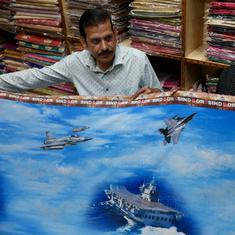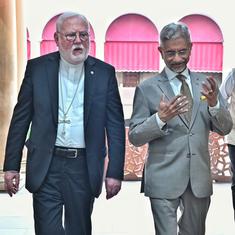Looking at the fate of overt as well as back-channel initiatives on Kashmir since 1947, when the word Kashmir acquired the connotation of a dispute, prudence demands a healthy dose of scepticism while assessing another such effort, this time by the Concerned Citizens Group led by former finance minister and senior Bharatiya Janata Party leader Yashwant Sinha.
As is now the custom for such groups, the delegation met separatist leaders of the Hurriyat and many other people during its two visits to the state since October. On January 7, it released its report. Unlike a group of parliamentarians who had failed to meet jailed Hurriyat leaders in the Valley during the peak of the uprising last year, the Sinha-led civil society group was not spurned by anyone.
Also, probably for the first time, the Dukhtaran-e-Millat, a women’s resistance group widely known for its fierce support to the armed insurgency and disdain for fruitless dialogue, called the delegation’s report “rational and reasonably balanced”. Asking the masses and intellectuals of India to “go through the report to understand Kashmir issue”, it inferred from the document that “Kashmiri voices have started reaching somewhere”. At the same time, however, it said that resolving the Kashmir dispute “needed no new formulas as the solution is already enshrined in the UN resolutions”.
What has made the report resonate in Kashmir is, by and large, a seemingly objective representation of the situation on the ground. But therein lies the problem.
The report says that all Kashmiris hark back to Atal Behari Vajpayee’s proposal of resolving Kashmir “within the ambit of humanity” as something that offered a ray of hope. All Kashmiris? Really? Did no Kashmiri categorically demand azadi? Not even in South Kashmir, which only six months ago slipped out of the state’s control and had to be won back with military might?
“Almost every Kashmiri we met said there was a need for a one-time political settlement,” said the report. That is an old demand, at least 27 years old now. Older, if other pre-1990 political movements are acknowledged. But it may be asked, was there no definite articulation of that political settlement, like azadi, Pakistan, India, Independence, autonomy, this time? Did any of the tens of hundreds of people injured during last year’s summer uprising really say “Kashmiris have lost faith in India because India has failed them”? Wasn’t the loss of faith responsible for the uprising, or the armed revolt of 1990, in the first place?
Ineffective reports?
The framing of reports of such political initiatives has been problematic in the past too. The three interlocutors appointed by the government in the aftermath of the 2010 unrest, after an elaborate engagement with various sections of people in all regions of the state, called the demand for azadi a “soulless dirge”.
Another factor that makes these initiatives problematic, and probably ineffective in the end, is the tendency to slyly juxtapose a set of diverse complaints and demands from an unidentified heterogeneous group of people and club it into a report that is sought to be used as a roadmap for a short-term or long-term solution. For example, while explaining how people talk of yet another uprising, more intense than 2016, if the situation doesn’t change, the group slips in this finding: “They point out that neither the president nor the prime minister of India had participated in the last rites and burial of former Chief Minister Mufti Mohammad Sayeed, while both had rushed to Chennai when [chief minister] Jayalalithaa passed away. They contrasted the way two gold medal-winning sportspersons – PV Sindhu and young Tajamul Islam – were felicitated on their return from abroad.”
Hardly 5,000 Kashmiris – a sizeable number of them bureaucrats, politicians, ministers and their security detail – participated in the late Mufti’s funeral prayers at Srinagar. Why would the non-participation of the prime minister or president bother Kashmiris when they themselves stayed away from his last rites?
The people who made this point probably wanted to convey how India itself views Kashmiris in a bid to drive home the point of the emotional separation that happened a long time ago between Srinagar and New Delhi.
But this point can also mean that Kashmiris expect emotional warmth from India.
However, such a possibility is negated by another finding mentioned in the report, which says, “There is a near complete lack of faith in anything that the government of India says or promises because of a history of broken commitments. Even among those who say that they see a future with India, there is anger that India has not done enough to keep the Kashmiris with it.”
Telling it as it is
As Sinha has said after submitting the report, one must not give up hope. But let hope spring from an honest appraisal of the situation on the ground and then seek solutions that are in sync with that ground sentiment.
The situation on the ground tells us that although the people see last year’s uprising as an organic reaction to “betrayals by India”, the highest elected representative of the state, Chief Minister Mehbooba Mufti, calls it pre-planned violence and blames the resistance leadership and Pakistan. Paradoxically, those killed by government forces during this “nihilistic violence” have been posthumously awarded Rs 5 lakhs each, while those blinded by pellets will be provided education in good schools. This is the same government that repeatedly says reconciliation is the only way to move forward.
Pointing out this paradox is important because the Concerned Citizens Group has recommended a dialogue with “all stakeholders”. Pro-India parties such as the National Conference and the ruling People’s Democratic Party also count as stakeholders even though, as a rule, they sound separatist while out of power and ruthless nationalists while in power. The vague “all stakeholders” has been used in the past, too, to undermine the dominant political sentiment by pitching the aspirations of various groups and communities against each other. Such exercises have involved viewing hoteliers or intellectuals as independent stakeholders, in isolation from the larger community.
The group, therefore, has, by and large, treaded the path of its predecessors, although it makes a few bold observations about the situation. Its future endeavours would be greatly helpful if it can institutionalise the process of identifying stakeholders rather than just looking to multiplying them each time Kashmir erupts, if the demand for azadi is not clubbed with a minority community’s lament about jobs, and if “trust deficit” and the willingness to face bullets for a political sentiment are not mistaken for each other.
Like the group members, we will also keep hoping.










